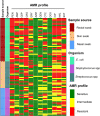Isolation of multidrug-resistant Escherichia coli, Staphylococcus spp., and Streptococcus spp. from dogs in Chattogram Metropolitan Area, Bangladesh
- PMID: 33409311
- PMCID: PMC7774779
- DOI: 10.5455/javar.2020.g466
Isolation of multidrug-resistant Escherichia coli, Staphylococcus spp., and Streptococcus spp. from dogs in Chattogram Metropolitan Area, Bangladesh
Abstract
Objectives: Antibacterial resistance is a great concern in human and food animal medicine, and it poses a significant concern in pet animals like dogs. This cross-sectional study was conducted to evaluate the antimicrobial resistance pattern of Escherichia coli, Staphylococcus spp., and Streptococcus spp. along with the carryover of some resistance genes in E. coli from dogs in the Chattogram metropolitan area, Bangladesh.
Materials and methods: Rectal swab (n = 50), nasal swab (n = 50), and skin swab (n = 50) samples were collected from dogs having respiratory infections, skin infections, and/or enteritis, respectively. Three types of bacteria were identified and isolated by conventional bacteriological techniques and biochemical tests. Antimicrobial susceptibility testing was carried out against 12 antimicrobials by disk diffusion methods. Six resistance genes, namely bla TEM, bla CTX-M, tetA, tetB, Sul-I, and Sul-II, were screened for phenotypically resistant E. coli isolates by the polymerase chain reaction.
Results: A total of 39 (78%) E. coli, 25 (50%) Staphylococcus spp., and 24 (48%) Streptococcus spp. isolates were isolated from the rectal swab, nasal swab, and skin swab samples, respectively. In the cultural sensitivity test, the E. coli isolates showed resistance to ceftriaxone (79%) and sulfamethoxazole/trimethoprim (64%). Doxycycline (80%) demonstrated the highest resistance among Staphylococcus isolates, followed by sulfamethoxazole/trimethoprim (60%). Streptococcus isolates showed the highest resistance to penicillin (63%), followed by ceftriaxone (54%), while no isolate showed resistance to gentamycin. The prevalence of bla TEM, bla CTX-M, tetA, tetB, Sul-I, and Sul-II genes in phenotypically resistant E. coli isolates were 100%, 61.29%, 100%, 8.33%, 56%, and 72%, respectively.
Conclusions: Spillover of such multidrug-resistant bacteria and resistance genes from pet dogs pose a serious public health risk.
Keywords: Antimicrobial resistance; common pathogens; dog; resistance genes.
Copyright: © Journal of Advanced Veterinary and Animal Research.
Conflict of interest statement
The authors have no potential conflict of interest.
Figures




Similar articles
-
Antibiotic resistance of Escherichia coli isolated from broilers sold at live bird markets in Chattogram, Bangladesh.J Adv Vet Anim Res. 2019 Jun 6;6(3):272-277. doi: 10.5455/javar.2019.f344. eCollection 2019 Sep. J Adv Vet Anim Res. 2019. PMID: 31583222 Free PMC article.
-
Detection of antibiotic-resistant canine origin Escherichia coli and the synergistic effect of magnolol in reducing the resistance of multidrug-resistant Escherichia coli.Front Vet Sci. 2023 Mar 15;10:1104812. doi: 10.3389/fvets.2023.1104812. eCollection 2023. Front Vet Sci. 2023. PMID: 37008355 Free PMC article.
-
Therapeutic effect of biosynthetic gold nanoparticles on multidrug-resistant Escherichia coli and Salmonella species isolated from ruminants.Vet World. 2021 Dec;14(12):3200-3210. doi: 10.14202/vetworld.2021.3200-3210. Epub 2021 Dec 29. Vet World. 2021. PMID: 35153413 Free PMC article.
-
Assessment of the presence of multidrug-resistant Escherichia coli, Salmonella and Staphylococcus in chicken meat, eggs and faeces in Mymensingh division of Bangladesh.Heliyon. 2024 Aug 23;10(17):e36690. doi: 10.1016/j.heliyon.2024.e36690. eCollection 2024 Sep 15. Heliyon. 2024. PMID: 39281621 Free PMC article.
-
Prevalence of antimicrobial-resistant Escherichia coli in dogs in a cross-sectional, community-based study.Vet Rec. 2011 Apr 2;168(13):354. doi: 10.1136/vr.d1540. Epub 2011 Mar 23. Vet Rec. 2011. PMID: 21498238
Cited by
-
A Retrospective Study (2019-2023) on the Prevalence and Antimicrobial Resistance of Isolates from Canine Clinical Samples Submitted to the University Veterinary Hospital in Stara Zagora, Bulgaria.Microorganisms. 2024 Aug 14;12(8):1670. doi: 10.3390/microorganisms12081670. Microorganisms. 2024. PMID: 39203512 Free PMC article.
References
-
- Rakib TM, Islam MS, Nur-E-Azam M, Islam S, Faruq A. Al, Das T, et al. Multidrug resistance pattern of Salmonella typhimurium isolated from rectal swabs of stray dogs at Chittagong Metropolitan Area (CMA), Bangladesh. Microbiol Res J Int. 2018;25:1–11. https://dx.doi.10.9734/MRJI/2018/43939.
-
- Rheinwald M, Hartmann K, Hähner M, Wolf G, Straubinger RK, Schulz B. Antibiotic susceptibility of bacterial isolates from 502 dogs with respiratory signs. Vet Rec Open. 2015;176:357–7. https://dx.doi.10.1136/vr.102694. - PubMed
-
- Schaufler K, Bethe A, Lübke-Becker A, Ewers C, Kohn B, Wieler LH, et al. Putative connection between zoonotic multiresistant extended-spectrum beta-lactamase (ESBL)-producing Escherichia coli in dog feces from a veterinary campus and clinical isolates from dogs. Infect Ecol Epidemiol. 2015;5(1):25334. https://dx.doi.10.3402/iee.v5.25334. - PMC - PubMed
LinkOut - more resources
Full Text Sources
Miscellaneous
